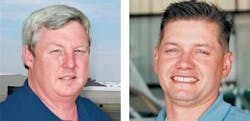KERRVILLE, TX -- The history of Louis Schreiner Field here has long been tied to Mooney Airplane Company, founded in 1946. While Mooney remains the airport's primary tenant, the fortunes of the airport are changing as director David Pearce leads an effort to revitalize the infrastructure and offer an array of services that are more in line with the business aviation market of today. Central to the initiative is an ILS and a new terminal building, which will also house line services for Kerrville Aviation, the lone fixed base operation. At the same time, a citywide economic development push has the airport at its core.
Located in the heart of the Texas Hill Country in the center of the state, Kerrville sits some 60 miles west of San Antonio and 100 miles southwest of Austin, the capital. In the 1990s, the San Antonio-Austin corridor experienced dramatic economic growth tied to the high-tech revolution. When the dot-com bust of the late '90s occurred, the region was hit hard. However, it is now poised for a rebound, and the dynamic brought about by the tech growth has changed the economics of the region long term.
Meanwhile, explains Joseph Kennedy, the president of Kerrville Aviation, a history of tourism, hunting, and second homes has maintained a business base that sees his operation on a growth track that is expected to see fuel sales increase in 2005 by more than 20 percent to more than 500,000 gallons, 70 percent of which is jet-A.
As the utilization of the airfield has changed to business aviation and away from its history of piston aircraft, tied to Mooney (see sidebar), the need for infrastructure improvements has heightened, explains Pearce.
"This airport started out primarily as a light general aviation airport, below 12,000 pounds," he says. "Right now, you can see that our customers and demand level is becoming a majority of turbine traffic, and we have to provide the infrastructure for that - security and control; runways and taxiways improvements; and the associated accommodations.
"Twenty years ago when a guy stepped off his airplane he was happy to sit on a front porch and put a dime in a payphone. Now, he's climbing out of a $20 million jet, has a laptop in hand, has a number of businesses he needs to take care of, and he needs to be accommodated. That's our next level: the business traveler.
Positioned for business
Since arriving here in 2003, Pearce has orchestrated the initial steps toward a total overhaul and upgrade of the airport. A centerpiece of the airfield development is a new GA terminal facility adjacent to Kerrville Aviation, which will serve as the facility's primary tenant.
He recently completed minimum standards guidance to help ensure a level playing field for newcomers, and expects that in time a second FBO is a real possibility. When that occurs, he says, Kennedy and the airport are in agreement that either the terminal will be split between the two or other concessions will be made to maintain competitive equality. "We have that provision in our minimum standards," says Pearce, "this isn't an exclusive rights situation."
Installation of the instrument landing system is in process, says Pearce, and a completed FAA feasibility study was returned favorable. The airport has acquired an additional 35 acres to accommodate the ILS installation, according to Pearce, due to significant terrain considerations.
Pearce has also just completed a renegotiation of all leaseholds on the airfield, including Mooney and the FBO, which now has two parcels under 30-year leases, including options. "One of the challenges we had was adjusting the airport to market rates," explains Pearce. "We didn't want to hurt businesses, but had to get to where we needed to be. Joe [Kennedy] was very helpful in adjusting his when he built his new corporate hangar."
Today, the airport charges 10 cents/sq.ft. for aviation businesses; 18 cents/sq.ft. for ramp access properties; and, has a fuel flow of 5 cents/gallon. "We've kept it at 5 cents intentionally," says Pearce. "We would like to see our volumes get up. It's our contribution to keeping the aviation market going and all of our businesses growing."
The airport is also nearing completion of $1 million in sewer, water, and power infrastructure upgrades to spur development of some 300 acres, says Pearce. The airport development is tied to efforts of both the Economic Improvement Corporation and the Kerrville Economic Development Foundation, an arm of the Chamber of Commerce. "We work hand in hand when a company comes in here," says Pearce.





